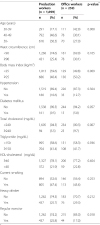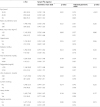1. Jemal A, Bray F, Center MM, Ferlay J, Ward E, Forman D. Global cancer statistics. CA Cancer J Clin. 2011; 61:69–90. DOI:
10.3322/caac.20107. PMID:
21296855.
3. Quinn M, Babb P. Patterns and trends in prostate cancer incidence, survival, prevalence and mortality. Part I: international comparisons. BJU Int. 2002; 90:162–173. DOI:
10.1046/j.1464-410X.2002.2822.x. PMID:
12081758.
5. Jung KW, Won YJ, Kong HJ, Oh CM, Lee DH, Lee JS. Cancer statistics in Korea: incidence, mortality, survival, and prevalence in 2011. Cancer Res Treat. 2014; 46(2):109–123. DOI:
10.4143/crt.2014.46.2.109. PMID:
24851102.
6. Cookson MM. Prostate cancer: screening and early detection. Cancer Control. 2001; 8:133–140. PMID:
11326167.
7. Schröder FH, Hugosson J, Roobol MJ, Tammela TL, Ciatto S, Nelen V, Kwiatkowski M, Lujan M, Lilja H, Zappa M, Denis LJ, Recker F, Berenguer A, Määttänen L, Bangma CH, Aus G, Villers A, Rebillard X, van der Kwast T, Blijenberg BG, Moss SM, de Koning HJ, Auvinen A; ERSPC Investigators. Screening and prostate-cancer mortality in a randomized European study. N Engl J Med. 2009; 360(13):1320–1328. DOI:
10.1056/NEJMoa0810084. PMID:
19297566.
8. Sirovich BE, Schwartz LM, Woloshin S. Screening men for prostate and colorectal cancer in the United States: does practice reflect the evidence? JAMA. 2003; 289:1414–1420. DOI:
10.1001/jama.289.11.1414. PMID:
12636464.
9. Andriole GL, Crawford ED, Grubb RL 3rd, Buys SS, Chia D, Church TR, Fouad MN, Gelmann EP, Kvale PA, Reding DJ, Weissfeld JL, Yokochi LA, O'Brien B, Clapp JD, Rathmell JM, Riley TL, Hayes RB, Kramer BS, Izmirlian G, Miller AB, Pinsky PF, Prorok PC, Gohagan JK, Berg CD; PLCO Project Team. Mortality results from a randomized prostate-cancer screening. N Engl J Med. 2009; 360(13):1310–1319. DOI:
10.1056/NEJMoa0810696. PMID:
19297565.
10. Catalona WJ, Richie JP, Ahmann FR, Hudson MA, Scardino PT, Flanigan RC, de Kernion JB, Ratliff TL, Kavoussi LR, Dalkin BL. Comparison of digital rectal examination and serum prostate specific antigen in the early detection of prostate cancer: results of a multicenter clinical trial of 6,630 men. J Urol. 1994; 151:1283–1290. PMID:
7512659.
11. Nadler RB, Humphrey PA, Smith DS, Catalona WJ, Ratliff TL. Effect of inflammation and benign prostatic hyperplasia on elevated serum prostate specific antigen levels. J Urol. 1995; 154(2 Pt 1):407–413. DOI:
10.1016/S0022-5347(01)67064-2. PMID:
7541857.
12. Oesterling JE, Jacobsen SJ, Chute CG, Guess HA, Girman CJ, Panser LA, Lieber MM. Serum prostate-specific antigen in a community-based population of healthy men: establishment of age-specific reference ranges. JAMA. 1993; 270(7):860–864. DOI:
10.1001/jama.1993.03510070082041. PMID:
7688054.
13. Loprinzi PD, Kohli M. Effect of physical activity and sedentary behavior on serum prostate-specific antigen concentrations: results from the National Health and Nutrition. Examination Survey (NHANES), 2003-2006. Mayo Clin Proc. 2013; 88(1):11–21. DOI:
10.1016/j.mayocp.2012.10.012. PMID:
23274016.
14. Li J, Thompson T, Joseph DA, Master VA. Association between smoking status, and free, total and percent free prostate specific antigen. J Urol. 2012; 187(4):1228–1233. DOI:
10.1016/j.juro.2011.11.086. PMID:
22335864.
15. Zuccolo L, Lewis SJ, Donovan JL, Hamdy FC, Neal DE, Smith GD. Alcohol consumption and PSA-detected prostate cancer risk-a case-control nested in the ProtecT study. Int J Cancer. 2013; 132(9):2176–2185. DOI:
10.1002/ijc.27877. PMID:
23024014.
16. Bañez LL, Hamilton RJ, Partin AW, Vollmer RT, Sun L, Rodriguez C, Wang Y, Terris MK, Aronson WJ, Presti JC Jr, Kane CJ, Am Ling CL, Moul JW, Freedland SJ. Obesity-related plasma hemodilution and PSA concentration among men with prostate cancer. JAMA. 2007; 298(19):2275–2280. DOI:
10.1001/jama.298.19.2275. PMID:
18029831.
19. Clemes SA, Patel R, Mahon C, Griffiths PL. Sitting time and step counts in office workers. Occup Med (Lond). 2014; 64(3):188–192. DOI:
10.1093/occmed/kqt164. PMID:
24477502.
20. Schreuder KJ, Roelen CA, Koopmans PC, Groothoff JW. Job demands and health complaints in white and blue collar workers. Work. 2008; 31(4):425–432. PMID:
19127013.
21. Griffiths K. Molecular Control of Prostate Growth. Textbook of Benign Prostatic Hyperplasia. 1996. Oxford, UK: Isis Medical Media Ltd;p. 23–26.
22. Dal Maso L, Zucchetto A, Tavani A, Montella M, Ramazzotti V, Polesel J, Bravi F, Talamini R, La Vecchia C, Franceschi S. Lifetime occupational and recreational physical activity and risk of benign prostatic hyperplasia. Int J Cancer. 2006; 118(10):2632–2635. DOI:
10.1002/ijc.21668. PMID:
16380994.
23. Friedenreich CM, Thune I. A review of physical activity and prostate cancer risk. Cancer Causes Control. 2001; 12:461–475. DOI:
10.1023/A:1011210121901. PMID:
11545461.
24. Whittemore AS, Cirillo PM, Feldman D, Cohn BA. Prostate specific antigen levels in young adulthood predict prostate cancer risk: results from a cohort of Black and White Americans. J Urol. 2005; 174(3):872–876. DOI:
10.1097/01.ju.0000169262.18000.8a. PMID:
16093978.
25. Antenor JA, Han M, Roehl KA, Nadler RB, Catalona WJ. Relationship between initial prostate specific antigen level and subsequent prostate cancer detection in a longitudinal screening study. J Urol. 2004; 172(1):90–93. DOI:
10.1097/01.ju.0000132133.10470.bb. PMID:
15201744.
26. Fang J, Metter EJ, Landis P, Chan DW, Morrell CH, Carter HB. Low levels of prostate-specific antigen predict long-term risk of prostate cancer: results from the Baltimore Longitudinal Study of Aging. Urology. 2001; 58(3):411–416. DOI:
10.1016/S0090-4295(01)01304-8. PMID:
11549490.
27. Berglund A, Garmo H, Robinson D, Tishelman C, Holmberg L, Bratt O, Adolfsson J, Stattin P, Lambe M. Differences according to socioeconomic status in the management and mortality in men with high risk prostate cancer. Eur J Cancer. 2012; 48(1):75–84. DOI:
10.1016/j.ejca.2011.07.009. PMID:
21852113.
29. Lagiou A, Samoli E, Georgila C, Minaki P, Barbouni A, Tzonou A, Trichopoulos D, Lagiou P. Occupational physical activity in relation with prostate cancer and benign prostatic hyperplasia. Eur J Cancer Prev. 2008; 17(4):336–339. DOI:
10.1097/CEJ.0b013e3282f5221e. PMID:
18562958.
30. Krishnadasan A, Kennedy N, Zhao Y, Morgenstern H, Ritz B. Nested case-control study of occupational physical activity and prostate cancer among workers using a job exposure matrix. Cancer Causes Control. 2008; 19(1):107–114. DOI:
10.1007/s10552-007-9076-7. PMID:
18064535.








 PDF
PDF Citation
Citation Print
Print


 XML Download
XML Download